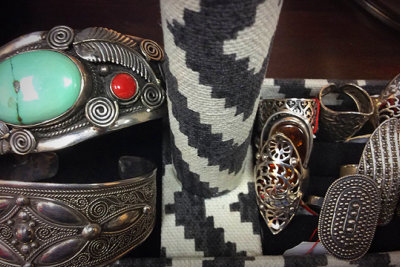
The Art of jewelry
In both urban and rural areas, the art of jewelry is one of the high points of handicraft, using gold and silver and reflecting the shine of gems.
Rural jewels
In past as in present days, stands of amber, coral, and fibulas (“Tinerzai” in Berber), festive adornments or hinged bracelets worn are offered on the occasion of engagements and add to the distinction of Berber women. Guardians of the legacy of the genuine know-how in handicraft, the cities of Tiznit, Laayoun, Guelmim and Essaouira have always been strongholds of silver and gem crafting.
Urban jewels
Just imagine the dazzle of emeralds, the shine of diamonds, the glow of garnet or the pureness of rubies curled up in the heart of finely craved floral design! The chemistry of gold and light further enhanced by the undisputed talent of goldsmith of Fez, Rabat, and Tetouan produce jewels ever more precious and ever more sumptuous. The intuition and rich imagination of seasoned artisans has succeeded in restyling and modernizing the hand of Fatima (Khmissa) symbolizing protection and source of inspiration.
Costume jewelry
Another fact of the art of jewelry and not the least important is that of costume jewelry. Key rings, page markers, and necklaces. These fashion-oriented creations more cosmopolitan with innovative materials are sensational and highly appreciated. Authentic and dynamic new art that captures the eye of even the most beautiful and discriminating women in Morocco and elsewhere.
The matter of our souls
In the hands of Moroccan master goldsmiths, precious metals (gold, silver) become textile fibers. Gold is turned into threads further woven, knotted or assembled to from cascades of pendant stones. In the kingdom of jewels, the neo-jewels introduce a bit of fantasy…soft and fresh colors of these items and modern natural materials such as thread and braiding; they upload the ;liberty of taste and the inventiveness of creators.



